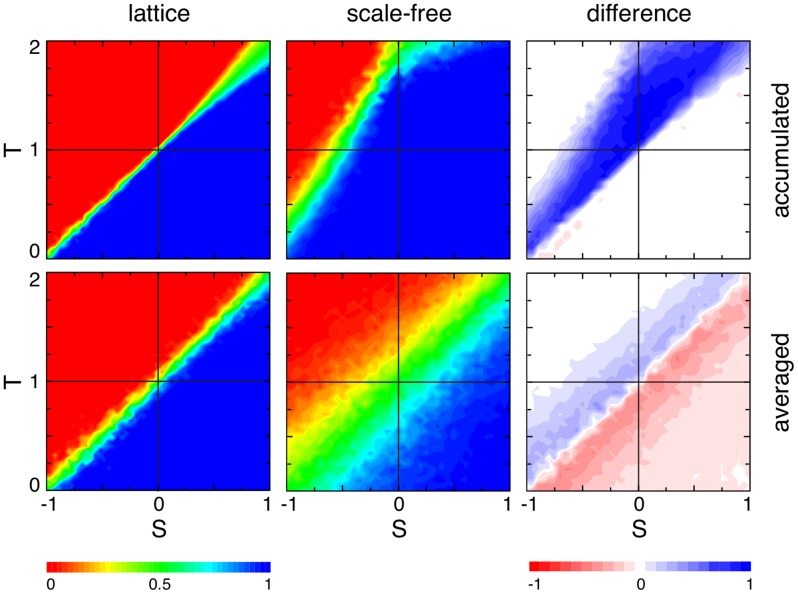Figure 3. Average fraction of strategy  for accumulated (top row) versus averaged (bottom row) payoffs in homogenous (left column) and heterogeneous (middle column) populations as well as the difference between them (right column) as a function of the game parameters
for accumulated (top row) versus averaged (bottom row) payoffs in homogenous (left column) and heterogeneous (middle column) populations as well as the difference between them (right column) as a function of the game parameters  and
and  (see Table 1).
(see Table 1).
In each panel the four quadrants indicate the four basic types of generalized social dilemmas: prisoner's dilemma (upper left), snowdrift or co-existence games (upper right), stag hunt or coordination games (lower left) and harmony games (lower right). Homogenous populations are represented by  lattices with von Neumann neighbourhood (degree
lattices with von Neumann neighbourhood (degree  ) and heterogenous populations are represented by Barabási-Albert scale-free networks (size
) and heterogenous populations are represented by Barabási-Albert scale-free networks (size  , average degree
, average degree  ). The population is updated according to the imitation rule Eq. (9). The colours indicate the equilibrium fraction of strategy
). The population is updated according to the imitation rule Eq. (9). The colours indicate the equilibrium fraction of strategy  (left and middle columns) ranging from
(left and middle columns) ranging from  dominates (blue), equal proportions (green), to
dominates (blue), equal proportions (green), to  dominates (red). Increases in equilibrium fractions due to heterogeneity are shown in blue shades (right column) and decreases in shades of red. The intensity of the colour indicates the strength of the effect. Accumulated payoffs in heterogenous populations shift the equilibrium in support of the more efficient strategy
dominates (red). Increases in equilibrium fractions due to heterogeneity are shown in blue shades (right column) and decreases in shades of red. The intensity of the colour indicates the strength of the effect. Accumulated payoffs in heterogenous populations shift the equilibrium in support of the more efficient strategy  except for harmony games where
except for harmony games where  dominates in any case (bottom right quadrant). Conversely, for averaged payoffs the support of strategy
dominates in any case (bottom right quadrant). Conversely, for averaged payoffs the support of strategy  is much weaker and even detrimental for
is much weaker and even detrimental for  . Parameters: initial configuration is a random distribution of equal proportions of strategies
. Parameters: initial configuration is a random distribution of equal proportions of strategies  and
and  ; each simulation run follows
; each simulation run follows  updates and the equilibrium frequency of
updates and the equilibrium frequency of  is averaged over the last
is averaged over the last  updates; results are averaged over
updates; results are averaged over  independent runs; for scale-free networks the network is regenerated every
independent runs; for scale-free networks the network is regenerated every  runs. No mutations occured during the simulation run.
runs. No mutations occured during the simulation run.

